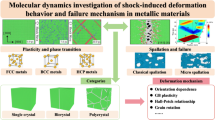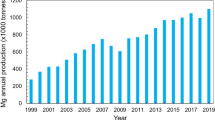Abstract
Pure copper monocrystals with [001] and [\(\bar 1\)34] orientations were subjected to ultrashort shock pulses ranging in initial duration from 2.5 to 10 ns, induced by a laser at energies ranging from 10 to 70 MJ/m2. The deformation structure was significantly dependent on the crystallographic orientation and depth from the laser-impacted surface, as characterized by transmission electron microscopy (TEM). The threshold pressure for twinning in the [001] direction was observed to be in the range of 20 to 40 GPa compared with 40 to 60 GPa for the [\(\bar 1\)34] orientation. Dislocation densities were also different for the two orientations, under similar shock conditions. The [\(\bar 1\)34] dislocation density was systematically lower. This is attributed to the activation of fewer slip systems resulting in a lower rate of hardening. The different results found for [001] and [\(\bar 1\)34] copper single crystals are described and effects of pressure decay in [\(\bar 1\)34] specimens are discussed. Differences in the mechanical response between the two orientations are responsible for differences in the shear stress in the specimens at the imposed pressures and associated strains. The [\(\bar 1\)34] orientation is initially subjected to deformation by single slip, (111)[101], which has a Schmid factor of 0.4711 and a well-defined easy glide region followed by a cross-slip regime with secondary slip. The [001] orientation has eight slip systems {111}〈110〉 with identical Schmid factors of 0.4082, which lead to immediate work hardening. At an imposed and prescribed pressure (that establishes the strain), the [\(\bar 1\)34] orientation exhibits a lower shear stress. The orientation dependence of the twinning stress is much lower, as expressed by Schmidt factors. This higher stress for [001] predisposes the onset of twinning in this orientation. The results are interpreted in terms of a criterion in which slip and twinning are considered as competing mechanisms. A constitutive description using a modified mechanical threshold stress (MTS) model is applied to the two orientations, incorporating both slip and twinning. The threshold pressure for twinning is calculated, considering the effect of shock heating. The constitutive description provides a rationale for the experimental results: the calculated thresholds are 17 GPa for [001] and 25 GPa for [\(\bar 1\)34].
Similar content being viewed by others
References
C.S. Smith: Trans. AIME, 1958, vol. 212, pp. 574–78.
Q. Johnson, A. Mitchell, R.N. Keeler, and L. Evans: Phys. Rev. Lett., 1970, vol. 25, pp. 1109–11.
E. Zaretsky: J. Appl. Phys., 1995, vol. 78, pp. 3740–47.
J.S. Wark, R.R. Whitlock, A.A. Hauer, J.E. Swain, and P.J. Solone: Phys. Rev. B, 1989, vol. 40, pp. 5705–14.
M.A. Meyers, F. Gregori, B.K. Kad, M.S. Schneider, D.H. Kalantar, B.A. Remington, J.S. Wark, T. Boehly, and G. Ravichandran: in Shock Compression of Condensed Matter—2001, M.D. Furnish, N.N. Thadhani, and Y. Horie, eds., AIP, New York, NY, 2002, pp. 619–22.
M.A. Meyers, F. Gregori, B.K. Kad, M.S. Schneider, D.H. Kalantar, B.A. Remington, G. Ravichandran, and T. Boehly: Acta Mater., 2003, vol. 51, pp. 1211–28.
O. Johari and G. Thomas: Acta Metal., 1964, vol. 12, pp. 1153–59.
L.E. Murr: in Shock Waves and High-Strain-Rate Phenomena in Metals, M.A. Meyers and L.E. Murr, eds., Plenum, New York, NY, 1981, pp. 607–73.
F.I. Grace: J. Appl. Phys., 1969, vol. 40, pp. 2649–57.
G.T. Gray III: in Shock-Wave and High-Strain-Rate Phenomena in Materials, M.A. Meyers, L.E. Murr, and K.P. Staudhammer, eds., Marcel Dekker, New York, NY, 1992, pp. 899–902.
E. Hornbogen: Acta Metal., 1962, vol. 10, pp. 978–86.
M.A. Meyers: Scripta Metall., 1978, vol. 12, pp. 21–26.
J. Weertman: in Shock Waves and High Strain Rate Phenomena in Metals, M.A. Meyers and L.E. Murr, eds., Plenum Press, New York, NY, 1981, pp. 469–86.
M. Mogilevskii: Phys. Rep., 1983, vol. 97, pp. 359–62.
R.J. De Angelis and J.B. Cohen: J. Met., 1963, vol. 15, pp. 681–87.
D.H. Kalantar, J. Belak, E. Bringa, K. Budil, M. Caturla, J. Colvin, M. Kumar, K.T. Lorenz, R.E. Rudd, J. Stolken, A.M. Allen, K. Rosolankova, J.S. Wark, M.A. Meyers, and M.S. Schneider: Phys. Plasmas, 2003, vol. 5, pp. 1569–76.
J. Lindl: Phys. Plasmas, 1995, vol. 2, pp. 3933–82.
R.L. Nolder and G. Thomas: Acta Metall., 1963, vol. 11, pp. 994–1001.
R.L. Nolder and G. Thomas: Acta Metall., 1964, vol. 12, pp. 227–40.
J. Diehl: Z. Metallkd., 1956, vol. 47, pp. 331–41.
L.E. Murr, M.A. Meyers, C.-S. Niou, Y.-J. Chen, S. Pappu, and C. Kennedy: Acta Mater., 1997, vol. 45, pp. 157–75.
M.A. Meyers, D.J. Benson, O. Voehringer, B.K. Kad, Q. Xue, and H.-H. Fu: Mater. Sci. Eng., 2002, vol. A322, pp. 194–216.
L.E. Murr: in Shock Waves in Condensed Matter, S.C. Schmid and N.C. Holmes, eds., Elsevier, Amsterdam, 1988, pp. 315–20.
J.W. Swegle and D.E. Grady: J. Appl. Phys., 1985, vol. 58, pp. 692–701.
M.A. Meyers: Dynamic Behavior of Materials, John Wiley, New York, NY, 1994, p. 150.
P.S. Follansbee and G.T. Gray III: Mater. Sci. Eng., 1991, vol. 138, pp. 23–31.
P.S. Follansbee: in Metallurgical Applications of Shock-Wave and High-Strain Rate Phenomena, L.E. Murr, K.P. Staudhammer, and M.A. Meyers, eds., Marcel Dekker, New York, NY, 1986, pp. 451–79.
M.A. Meyers, O. Voehringer, and V.A. Lubarda: Acta Mater., 2001, vol. 49, pp. 4025–39.
Author information
Authors and Affiliations
Additional information
This article is based on a presentation given in the symposium “Dynamic Deformation: Constitutive Modeling, Grain Size, and Other Effects: In Honor of Prof. Ronald W. Armstrong,” March 2–6, 2003, at the 2003 TMS/ASM Annual Meeting, San Diego, California, under the auspices of the TMS/ASM Joint Mechanical Behavior of Materials Committee.
Rights and permissions
About this article
Cite this article
Schneider, M.S., Kad, B.K., Meyers, M.A. et al. Laser-induced shock compression of copper: Orientation and pressure decay effects. Metall Mater Trans A 35, 2633–2646 (2004). https://doi.org/10.1007/s11661-004-0209-2
Issue Date:
DOI: https://doi.org/10.1007/s11661-004-0209-2




